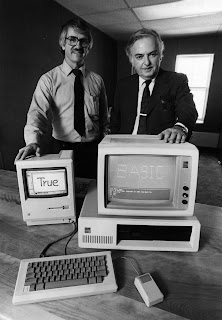 In 1964, John Kemeny and Thomas Kurtz produced the first version of the programming language Dartmouth BASIC. As part of the Dartmouth Time-Sharing System, one of the goals of the project was to provide less-technically inclined users with a way to use a computer without having to learn as many of the specialized mathematical skills that had been necessary up until that time.
In 1964, John Kemeny and Thomas Kurtz produced the first version of the programming language Dartmouth BASIC. As part of the Dartmouth Time-Sharing System, one of the goals of the project was to provide less-technically inclined users with a way to use a computer without having to learn as many of the specialized mathematical skills that had been necessary up until that time. Based on earlier languages, especially FORTRAN II and ALGOL 60, Dartmouth BASIC was a more user-friendly language and made heavy use of English words for statements. In his oral history interview from 2002, Kurtz relates that "Kemeny had the idea that all statements in BASIC, not just most, but all of them should start with an English word" as this would be more intuitive and easily remembered by users. Kurtz goes on to say that "bringing computing to the people, having a simplified user interface that really was simple to use, using English words that were easy to remember" were all part of what made Dartmouth BASIC so useful and widespread. Shown here are Kurtz and Kemeny with True BASIC, one of the successors to Dartmouth BASIC.
Rauner Library holds the papers of John Kemeny (MS-988) and Thomas Kurtz (MS-1144), as well as numerous other resources related to the development of BASIC.
